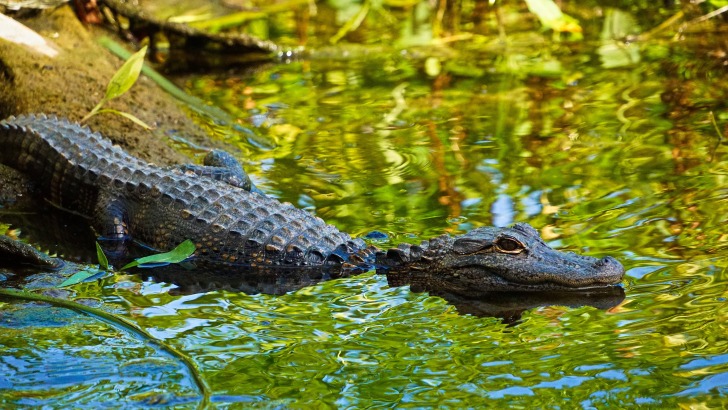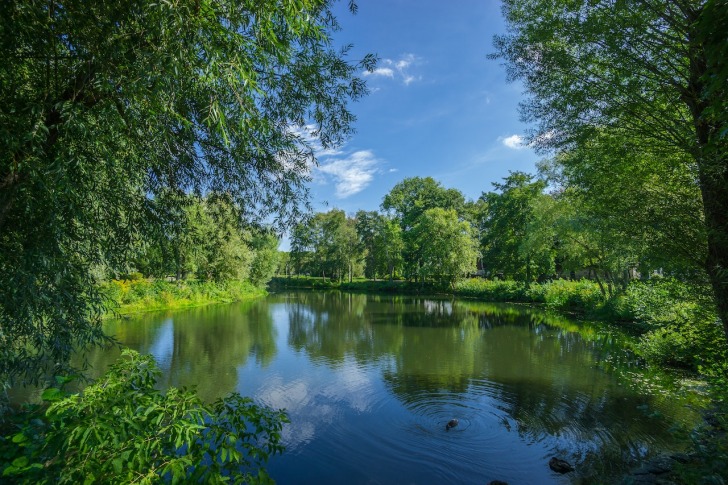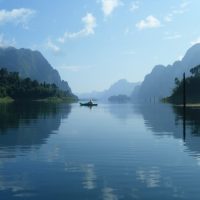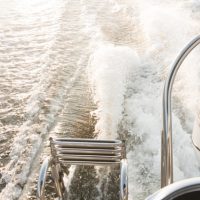Traversing Coosa, Elmore, and Tallapoosa counties, Lake Martin, Alabama, is an artificial reservoir on the Tallapoosa River formed by the Martin Dam.
With construction completed on the dam in 1926, Lake Martin was the largest manmade body of water in the world at the time.
Today, the lake continues to be one of the largest artificial bodies of water in the U.S. and is a popular destination for golfing, camping, water skiing, fishing, boating, and swimming.
In addition, with the lake being almost 100 years old, there has been plenty of time for wildlife to make its way into and near the shores.
Since Lake Martin is centrally situated in Alabama, you may wonder if alligators are along the shoreline.
Keep reading to learn more!
Contents
So… Are There Alligators in Lake Martin
Since Lake Marting is so far inland, there have been no reports of alligators near the lake.
With Lake Martin being such a tourist attraction, there are constantly watersport enthusiasts zipping around the lake.
Also, the winter temperatures are much cooler compared to the Gulf Coast region of Alabama, so gators cannot survive this far inland.
Is it Safe to Swim in Lake Martin?
Lake Martin is a safe place to swim, but there are some precautions you must take before taking a dip.
Be Cognizant of Boats
Watersports are the most popular activity on Lake Martin, so it’s critical to be aware of your surroundings at all times, especially when not sticking to designated areas.
You want to avoid boating channels where the loading and unloading of boats occur, specifically docks and marinas.
If you venture too far onto the lake, you could be struck and injured by a boat without the driver and passengers noticing.
Designated Swimming Areas
There are a variety of beaches with designated swimming areas with lifeguards around Lake Martin, so stick to those sections.
Swimming in non-designated areas with nobody around can be incredibly dangerous if an in-water emergency arises.
Lifeguards are there to keep the population safe, so it’s best to stay in areas where they are located.
That also means respecting the on-duty hours and not swimming after those posted times.
Don’t Swim at Night
While you won’t find gators in the water, there are plenty of other predatorial creatures that come out to hunt at dusk and throughout the night.
Therefore, don’t decide to take a dip at night when nobody is around.
An animal could attack you, and if there is an emergency, nobody will be around to assist.
Bring a friend for safety if you must go swimming at night.
The buddy system works!
Rip Currents
While you tend to find a higher risk of rip currents in the ocean, they can occur in specific areas of lakes, all of which are away from the designated swimming areas.
This is another reason to stick to the areas created for swimming.
Also, rip currents can appear on Lake Martin during inclement weather, so it’s best to stay inside during a storm.
Sun Exposure
Of the considerations on this list, sun exposure is probably the most critical and most ignored.
The Alabama sun in the summer is incredibly strong, so you can easily experience severe burns over a brief period, especially when swimming in cool, calm, and reflective waters.
That means you must apply and reapply high-SPF sunscreen throughout the day.
In the immediate, you could get a severe sunburn, which could damage your skin and be incredibly painful. Prolonged sun exposure can lead to skin cancer and other skin-related issues.
Interesting Alligator Facts in Lake Martin
While there are no confirmed alligators in the lake, every few years, there are reports of gators being spotted, which are quickly dismissed by local wildlife groups.
In May 2022, reports of a deer-eating, 14-foot alligator being on the loose in Lake Martin, but the Alabama Forestry Commission said this was false information.
The only possibility that a gator could get into the lake is if a resident kept it as a pet, then released the reptile into the wild when it grew to be too large.
If there were gators in the lake, they would be the American alligator, which has these interesting facts:
- Alligators start reproducing between 10 and 12 years old.
- American alligators are the largest crocodilians located only in the U.S.
- An alligator’s tail helps propel them through the water, and their webbed feet make them excellent swimmers.
- Gators are cold-blooded, so they are dependent on the local environment to provide warmth.
- Gators bask on rocks in the sun or dig holes into trapping heat.
- Gators can grow to be over 12 feet and weigh over 1,000 pounds.
- Male alligators are always slightly larger than female gators.
- Sometimes gators appear to be a log floating on the water.
- The animal’s skin is made up of scutes, which are small, boney scales used to provide protection.
- You can find alligators are far north as coastal Carolina and as far west as coastal Texas.

Alligators vs. Crocodiles
In the southern portion of Alabama, close to the Gulf of Mexico coastline, you will find the largest nesting areas of alligators.
However, many visitors confuse them for crocodiles, but there are discernable physical and behavioral differences to consider, including:
Aggressiveness
Unless they feel threatened or you venture near their young, gators are scared of humans and will try to move away from you as fast as possible using a quick retreat.
They only attack as a fight or flight mechanism, or they mistake you for prey.
On the other hand, crocodiles are opportunistic predators, which means they see you or anything that moves as prey and will attack immediately.
Location
While alligators can tolerate salt water for short periods, their body cannot process the salinity of the water, so they always seek freshwater marshes, swamps, rivers, and lakes.
Since southern Alabama has plenty of moisture and wetlands, gators prefer this area to the central part of the state, where Lake Martin is located.
Crocodiles are the opposite in that they prefer saltwater over freshwater and can be found along coastlines.
Florida is the only place on Earth where crocs and gators live in close proximity, although in separate bodies of water.
Physical Features
While this is not a hard-fast rule, gators tend to be dark green or blackish with small receptor spots near the jaw to detect water pressure and ripples while swimming.
Crocs are most consistently a camouflage pattern of greens, grey, brown, and black to help them blend into the surrounding brush.
In addition to color, the snout and jaws are clear indicators of the reptile type.
Alligators have a u-shaped snout with oval teeth and a jaw that closes downward, so you can only see the top teeth.
Crocodiles feature V-shaped snouts with pointed teeth and a jaw that closes to the top, thus exposing all teeth.
Alligators were created to crush prey with their strong jaws.
Crocodiles tend to tear apart their prey with razor-sharp teeth.
Size
The average American alligator is much smaller than the typical crocodile.
Male alligators grow to around 16 feet, whereas male crocodiles grow to around 23 feet.
While you don’t want to have a run-in with alligators or crocodiles, the largest size makes crocodiles even more deadly than alligators.
Type
While the type is not a physical indicator of an alligator or crocodile, it’s important to know that only two species of alligator exist: the American and Chinese gator, the ladder of which is going extinct.
On the other hand, there are 13 crocodile species located across the globe in warm-weather, wet, and saline environments.
All species of each type are members of the crocodilian family.
3 Safety Tips for Swimming in Alligator-infested Waters
Avoid Areas of Vegetation
Alligators tend to flock to areas of vegetation that poke through the water.
This protects them from the elements and humans while allowing them to hide and attack prey without warning.
If you decide to take the risk and swim in gator-infested waters, avoid areas of water vegetation, as there are likely alligator nests.
If female alligators have recently birthed offspring, they will be incredibly protective of this freshwater section, which could provoke them to attack if you get too close.
Give Gators a Clear Exit Path
If you come across an alligator in the water, let it pass, and never put the reptile in a situation where it feels cornered because this is when they attack.
Instead, you want to ensure the gator has a clear path for a quick retreat in the opposite direction.
Never Splash Around Excessively
In the mind of an alligator, splashing around could indicate a source of food in the water.
While alligators are not focused on eating humans, you could be mistaken for a large fish or animal taking a dip in or landing on top of the water.
By not drawing a scene in alligator-infested waters while swimming, you won’t be lunch for hungry lurking gators.
Summary
While Alabama has plenty of gators in the southern areas of the state, there is no evidence of the American alligator in Lake Martin, Alabama, which is in the central part of the state.
Lake Martin is a safe place to swim, but you must take normal precautions, like swimming in any populated body of water or being in the sun for prolonged periods.
You may come across other dangerous animals or snakes in or near the lake, but they won’t be alligators.
Alabama Safety Overview
READ THE FULL REPORT: Alabama Safety Review
Safety Index:
- OVERALL RISK: LOW
- TRANSPORT & TAXIS RISK: LOW
- PICKPOCKETS RISK: LOW
- NATURAL DISASTERS RISK: LOW
- MUGGING RISK: LOW
- TERRORISM RISK: LOW
- SCAMS RISK: LOW
- WOMEN TRAVELERS RISK: LOW
Frequently Asked Questions
What is the common diet of the American alligator?
American alligators are considered carnivores, consuming mammals, birds, frogs, invertebrates, and fish, they also eat fruit.
Recent studies have shown that fruit alligators consume spread seeds, which helps expand the growth of the local ecosystem.
How do alligators move around?
Alligators utilize a variety of movements by crawling, running, walking, and swimming.
Since their legs are directly beneath them, as opposed to a diagonal fashion, they can lift their tails off the ground during movement to make them faster.
When do American alligators hunt?
Most alligators hunt beginning at dusk and well throughout the night.
Small prey is directly eaten, but large prey is dragged underwater, drowned, and devoured.
The glottis is an adaptation within alligators that allows them to capture and consume prey while submerged in water.












I find it very hard to believe that there are no gators in Lake Martin. There have been gator sightings in every water way surrounding Lake Martin. In fact the largest gator ever found in AL was found less than 30 miles from Lake Martin in the AL River. It’s on display at the Mann Museum in Montgomery. They’re north of Lake Martin, so they dang sure aren’t “too far North” to be in Lake Martin. There are gator farms not far from Lake Martin, where the gators free roam in a large pond. If the weather wasn’t conducive for their survival, I don’t think those farms would still be around. Few and far between? Yes. Non existent? Absolutely not!
Lake Martin is NOT too far North – reason you don’t see alligators on Lake Martin is because of the two dams (Tallassee on Tallapoosa River/Yates) and the Lake Martin Dam itself – and the type water in lake (cool and clear) and how busy it is — There are plenty of alligators in the Tallapoosa River on the other side of the dam — I’m sure there are the occasional stray that finds it’s way around the dam, by foot – but the habitat is not suitable and they don’t stay. I live just down stream on the Tallapoosa River (beyond the dams) and there are plenty of alligators.